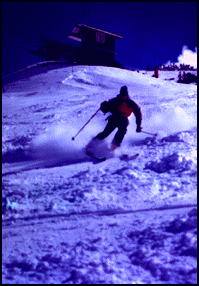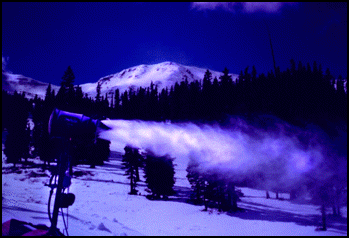December 1, 1995
In a dramatic, if somewhat silly, race, Colorado’s Keystone Resort narrowly beat out Loveland Ski Area on Oct. 13 to become the first ski area to open in Colorado.  Keystone won by a nose in the wee hours of the morning because of the banks of lights it uses for night skiing. Both areas relied heavily on snowmaking to open, a fact frowned upon by enviros, but relished both by ski fanatics who can’t wait to strap on the boards, and the marketing departments of Loveland and Keystone.
Keystone won by a nose in the wee hours of the morning because of the banks of lights it uses for night skiing. Both areas relied heavily on snowmaking to open, a fact frowned upon by enviros, but relished both by ski fanatics who can’t wait to strap on the boards, and the marketing departments of Loveland and Keystone.
A few weeks later, on Nov. 1, we visited Loveland, which is about 60 miles from Denver, and were pleasantly surprised with conditions. Mother Nature cooperated with 6 inches of fresh snow, and although only half a dozen or so runs were open, we got a good taste of Colorado skiing. Whether or not the conditions warranted a $25 lift ticket is questionable, but most people on the hill seemed more than happy to be frolicking in powder. The amount of open terrain was a tiny fraction of Loveland’s mountain, and intermediate to expert skiers were pretty much limited to two or three runs. Far from a mid-season ski experience, the early conditions nonetheless satisfied those of us who were a little rusty and eager to ski again. Since then, the Colorado mountains have received tons of snow, and nearly every ski area plans to open ahead of schedule.
The Loveland/Keystone race to open first has become an annual rite of autumn in Colorado, bestowing “first-to-open” bragging rights to the ski area that can make the most snow the quickest. From a marketing/promotional standpoint, the race nearly always garners national attention, providing invaluable exposure that plants Colorado skiing in the minds of skiers nationwide. As pre-dawn images of skiers racing down the hill flash nationwide, resort switchboards invariably light up.
From an environmental perspective, however, the rush to crank up snowmaking machines in late September to frost ski areas is a misplaced effort. “It’s ski industry hype,” said Rocky Smith, forest ecology coordinator for the Colorado Environmental Coalition. “It just seems silly … As a skier, I wouldn’t bother.” Smith explained that snowmaking is potentially harmful to local stream habitats. Water to make snow is taken from nearby streams during a time of year when they are typically at low levels.  Fish, said Smith, need deeper water, which usually doesn’t freeze, to survive the winter. However, actual damage to aquatic habitat is difficult to document and Keystone is aware of the potential problem and has implemented some mitigation measures. Snowmaking is often an essential component of establishing a good, rock-solid base and many resorts have invested millions of dollars in snowmaking equipment. Where Mother Nature fails to provide enough natural snow, resorts are ready to flip the switch and crank up their own variety of white stuff.
Fish, said Smith, need deeper water, which usually doesn’t freeze, to survive the winter. However, actual damage to aquatic habitat is difficult to document and Keystone is aware of the potential problem and has implemented some mitigation measures. Snowmaking is often an essential component of establishing a good, rock-solid base and many resorts have invested millions of dollars in snowmaking equipment. Where Mother Nature fails to provide enough natural snow, resorts are ready to flip the switch and crank up their own variety of white stuff.
1995 has been an extraordinary ski season in Colorado, with Arapahoe Basin open into August. Eleven months of skiing, we must admit, has a pretty nice ring to it, even if conditions are less-than stellar. As natural snow begins to accumulate in Colorado, most resorts will be opening up more and more terrain. However, if one is looking for a full mountain completely open, mid-December is probably the best bet. In the meantime, the hoary blast of snowmaking machines will continue to scream.
David Iler